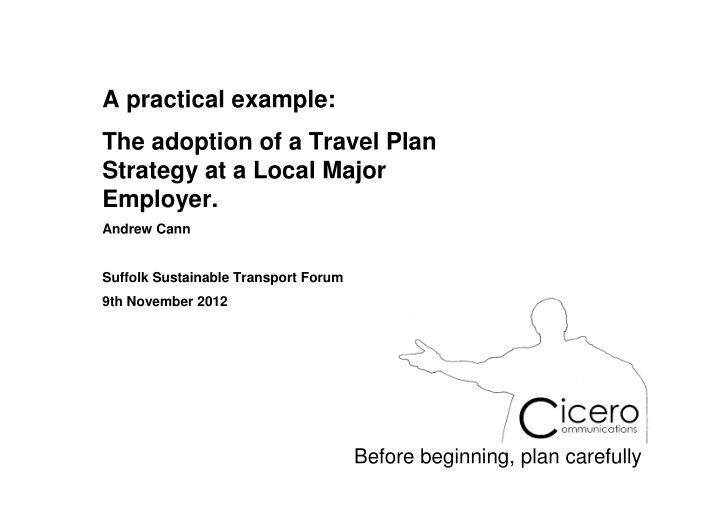



A practical example: The adoption of a Travel Plan Strategy at a Local Major Employer. Andrew Cann Suffolk Sustainable Transport Forum 9th November 2012 Before beginning, plan carefully
Cicero Communications • Introduction – Formerly Project Manager, Business Development at Hutchison Ports UK • The Travel Plan – Survey findings – Postcode analysis – The strategy • Public Transport – Buses – Rail – an example
Andrew Cann • Project Manager, Port Development Team, HPUK • Was responsible for: – FSR S.106 commitments – Planning / transport policy – A120 road improvements – Crossrail Petitions – Felixstowe Branchline and Ipswich Yard rail enhancements – Remote rail works (ECML) / liaison with NR / DfT / ORR / RFG • FSR S.106 commitments – Trimley(s) Acoustic Barrier – Freight Travel Management Plan – Travel Plan Policy So why were HPUK interested in public transport?
In order to build FSR…….. Felixstowe South Felixstowe South Reconfiguration (FSR) Reconfiguration (FSR) • 1350m Quay (16m) • 1350m Quay (16m) • 13 Quay Cranes • 13 Quay Cranes • • 50 RTGs 50 RTGs • • 5 Tugs/QC 5 Tugs/QC • Terminal 64.8 hectares • Terminal 64.8 hectares • Storage 46,800 TEU • Storage 46,800 TEU • • 1.96m TEU 1.96m TEU
The HPUK Travel Plan – SOV* target *SOV = Single Occupancy Vehicle. The reduction of SOV modal share is the principal aim of most Travel Plans.
SOV target issues In order to hit the SOV target 697 FTE’s must use an alternative mode of transport. This presents a number of challenges: The number of employees was set to increase from 2786 to 3056 over the period requiring an additional 68 FTE’s to change mode of transport In order to get sufficient FTE’s to change mode of transport a far larger number of employees must change behaviour for some of the time. Two-thirds of the workforce must choose a non-SOV mode 40% of the time to hit our target. That is no-mean feat! This makes targeting of key audiences more granular, time- consuming and costly. The Port of Felixstowe is located at the end of a 10 mile long peninsular - many ‘greener’ mode choices suit shorter distances. Diurnal range of shift start and stop times prohibits some modes due to safety / security issues – walking / cycling at night? Varying start times make car sharing and public transport solutions difficult to achieve Seasonality / inclement weather. When it’s cold and your shift starts at 06:30 are you going to wait at a bus stop?
Modal share (2005)
Postcode analysis – Felixstowe area Postcode analysis quickly demonstrated a number of opportunities: • 46% of employees live within the Felixstowe area – IP11 and IP10 • 16% of employees (428) live within IP11 2 – within 1.7km or walking distance • An additional 28% of employees (758) live within cycling distance
Postcode analysis – Ipswich & other 33% of employees (898) live within Ipswich Opportunities for car- sharing and possibly public transport Other large concentrations at Kesgrave, Martlesham, Woodbridge and Harwich suitable for car-sharing Reproduced by permission of Ordnance Survey on behalf of HMSO Ordnance survey licence number 100000000
Survey of employee preferences
Low hanging fruit?
Formulating a strategy We already identified through postcode analysis, the employee survey and cost/benefit analysis that the following Travel Plan elements would work best for the Felixstowe site: Working from home – cuts out any journey. Walking – minimal cost but limited opportunity Cycling – middling cost but some opportunity Car-sharing – higher cost but wider opportunity Public Transport ruled out at this stage. But working from home has been ruled out……….
Travel Plan Strategy
Car Sharing 300 exclusive parking spaces closer to buildings to be set up £10 Marks and Spencers vouchers for registering (1,500 registrations needed to deliver 300) FTE car sharers. Sign-up and learn lunches HPUK branded ‘liftshare’ software used with piggy-back on Suffolk Car-Share dataset. Software delivered August 2008 New post. Travel-plan Coordinator with marketing budget
Cycling and Walking Additional £150,000 for on-port cycleways and walkways New Oracle HR system to incorporate cycle loans New bike shelters – close to buildings Promotion of walking cycle and health benefits through Occupational Health centre Promotion of well trodden’ routes to local employees Shower facilities Provision of visibility strips etc.
Our employees views on buses . . . . . Dirty Noisy Expensive Not as ‘good’ as my car! Unreliable Inconvenient
Our views on Buses . . . . For shift workers and ‘9 to 5’ers’ frequency is less of an issue but reliability is essential Speed of service a key issue – not too many stops So.. HPUK think buses should be They must be clean quick, reliable, spotless and leave you with a warm glow after use. Is this too much to ask? Staff must be polite and helpful Fare policy must reward a ‘green’ choice
Thank you Andrew Cann, Cicero Communications andrew.cann@cicerocommunications.co.uk www.cicerocommunications.co.uk Before beginning, plan carefully
Recommend
More recommend